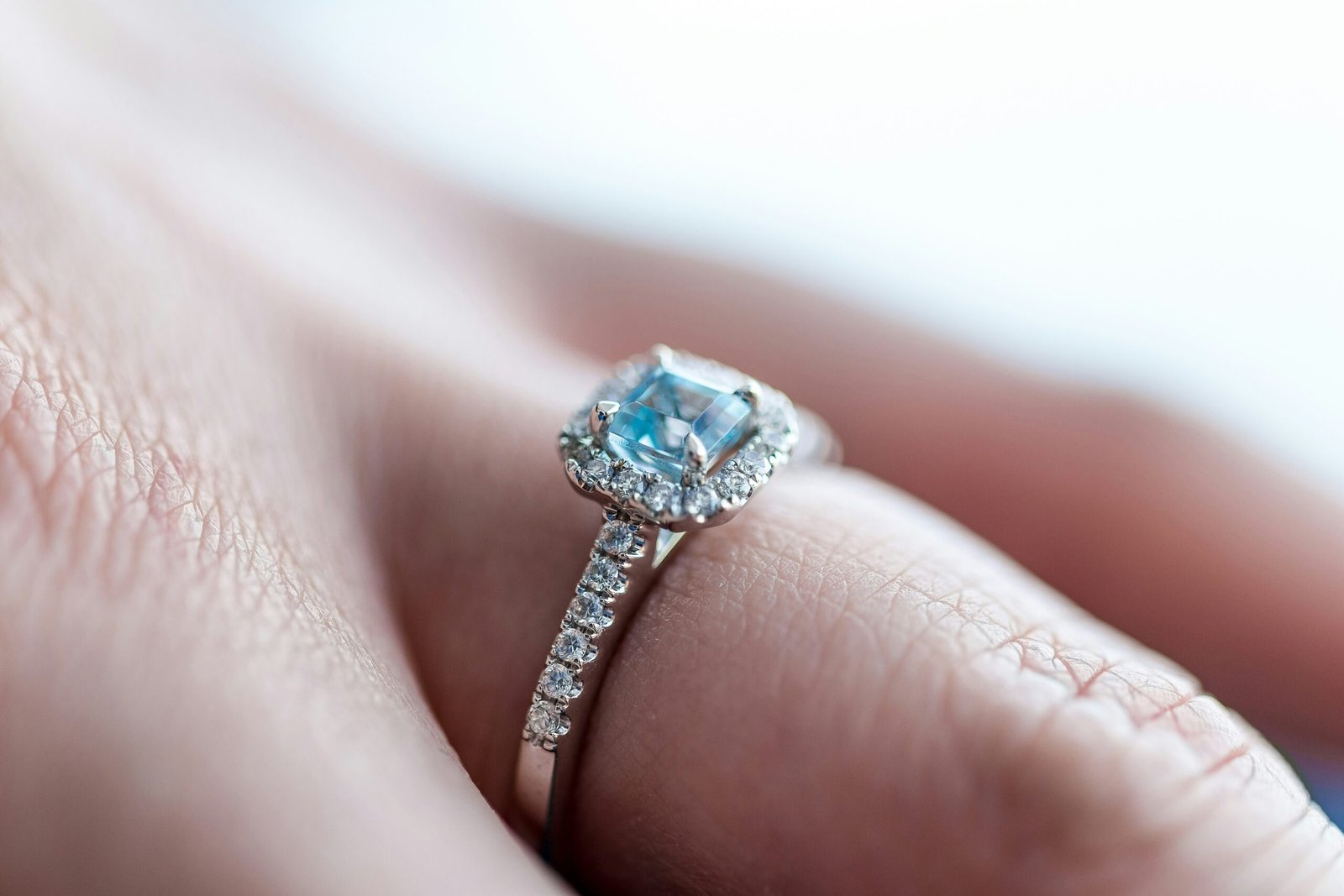
Aquamarine is a gemstone that has been highly valued throughout history for its beauty and symbolism. It has been used in jewelry and decorative items for centuries, and its popularity continues to this day. The gemstone is typically found in various shades of blue and green, ranging from pale pastel hues to deep, vibrant tones.
One of the reasons why aquamarine is so highly regarded is its association with water. In many cultures, water is seen as a symbol of purity, tranquility, and emotional healing. The serene blue-green color of aquamarine is believed to evoke these qualities, making it a popular choice for those seeking inner peace and emotional balance.
Aquamarine is also associated with the sea, and its color is often compared to the sparkling waters of tropical beaches. This connection to the ocean adds a sense of adventure and wanderlust to the gemstone. It is often used in jewelry designs that evoke a sense of the beach, with motifs such as seashells, waves, and dolphins.
In addition to its aesthetic appeal, aquamarine is also believed to have various metaphysical properties. It is said to enhance communication skills, encourage self-expression, and promote understanding between individuals. It is also thought to be a stone of courage and protection, helping to calm the mind and reduce stress.
Aquamarine is typically found in Brazil, but it can also be found in other parts of the world, including Madagascar, Nigeria, and the United States. The gemstone is relatively hard and durable, making it suitable for use in jewelry that will be worn daily.
When purchasing aquamarine, it is important to consider factors such as color, clarity, and size. The most valuable aquamarines are those that have a rich, saturated color and minimal inclusions. The size of the gemstone will also affect its value, with larger stones being more rare and therefore more expensive.
Overall, aquamarine is a gemstone that offers both beauty and symbolism. Whether worn as a piece of jewelry or used in a decorative item, it is sure to add a touch of elegance and serenity to any setting.
Aquamarine is a variety of beryl that ranges in color from pale blue to a greenish-blue hue. The intensity of the color depends on the amount of iron present in the crystal structure. The most valuable aquamarines are those with a rich, vibrant blue color. The stone is known for its transparency and clarity, which allows light to pass through and give it a radiant glow.
Aquamarine is a relatively hard gemstone, ranking 7.5 to 8 on the Mohs scale of hardness. This makes it durable and suitable for everyday wear. It has a vitreous luster and is often cut into various shapes, including round, oval, emerald, and pear.
One of the unique properties of aquamarine is its pleochroism, which means it can display different colors when viewed from different angles. In the case of aquamarine, it typically shows a pale blue color when viewed from one angle and a slightly greenish-blue color from another angle. This phenomenon adds to the stone’s allure and makes it visually captivating.
Another notable characteristic of aquamarine is its high level of clarity. Unlike many other gemstones, aquamarine is often found in large, clear crystals with minimal inclusions or flaws. This makes it highly sought after by collectors and jewelry enthusiasts.
In addition to its aesthetic appeal, aquamarine is also believed to possess various metaphysical properties. It is considered a stone of courage and protection, believed to enhance communication and promote self-expression. Many people also associate aquamarine with the soothing energy of the ocean, making it a popular choice for those seeking a sense of calm and tranquility in their lives.
Due to its popularity and unique characteristics, aquamarine is a highly valued gemstone in the jewelry industry. It is often used as the birthstone for the month of March and is a popular choice for engagement rings, necklaces, earrings, and other forms of jewelry. Whether worn as a fashion statement or for its metaphysical properties, aquamarine continues to captivate and inspire people around the world.
Symbolism and Meaning
Aquamarine has been cherished for centuries for its beauty and symbolism. It is often associated with the sea and has been believed to bring good luck and protection to sailors. In ancient times, it was also thought to be the treasure of mermaids, hence its connection to the ocean.
Aside from its maritime symbolism, aquamarine is also believed to have calming and soothing properties. It is said to promote harmony, balance, and tranquility, making it a popular choice for meditation and spiritual practices. Some also believe that aquamarine can enhance communication and self-expression.
The symbolism and meaning of aquamarine can vary across different cultures and traditions. In ancient Egypt, for example, aquamarine was associated with the goddess Isis and was believed to bring protection and foresight. In Greek mythology, it was associated with Poseidon, the god of the sea, and was believed to protect sailors and ensure a safe journey.
In addition to its association with the sea, aquamarine is also often linked to the element of water. Water is often seen as a symbol of emotions, intuition, and the subconscious mind. Aquamarine’s connection to water is believed to enhance these qualities, allowing individuals to tap into their intuition and emotions more easily.
Furthermore, aquamarine is believed to have healing properties, particularly in relation to the throat chakra. The throat chakra is associated with communication, self-expression, and the ability to speak one’s truth. Aquamarine is said to stimulate and balance this chakra, allowing individuals to express themselves more clearly and confidently.
Overall, aquamarine holds a rich symbolism and meaning that extends beyond its physical beauty. Whether it is worn as jewelry or used in spiritual practices, aquamarine is believed to bring a sense of calm, protection, and enhanced communication to those who embrace its energies.
Uses of Aquamarine
Aquamarine is primarily used as a gemstone in jewelry. Its beautiful blue color makes it a popular choice for rings, necklaces, earrings, and bracelets. It is often cut into faceted gemstones to enhance its brilliance and sparkle. Aquamarine jewelry is not only admired for its aesthetic appeal but also for its symbolic and spiritual significance.
In addition to its use in jewelry, aquamarine is also used in various other applications. Its vibrant blue color makes it a sought-after gemstone for collectors and enthusiasts. It is also used in decorative items, such as sculptures and carvings. Some people even use aquamarine in alternative healing practices, believing in its ability to promote emotional healing and well-being.
Furthermore, aquamarine is valued for its metaphysical properties and is often used in meditation and spiritual practices. It is believed to have a calming and soothing effect on the mind and body, helping to reduce stress and anxiety. Many people use aquamarine crystals or wear aquamarine jewelry during meditation to enhance their spiritual connection and promote a sense of inner peace.
In the world of fashion, aquamarine is a versatile gemstone that can be incorporated into various styles and designs. Its light blue color adds a touch of elegance and sophistication to any outfit. Aquamarine jewelry can be worn casually, as well as for special occasions, making it a versatile accessory for both men and women.
Aside from its aesthetic and spiritual uses, aquamarine also has practical applications. Due to its hardness and durability, aquamarine is sometimes used in industrial settings. It can be used as a cutting tool for hard materials, such as glass and metal. Additionally, aquamarine is used in scientific research and experimentation, particularly in the field of optics and laser technology.
In conclusion, aquamarine is a gemstone with a wide range of uses and applications. From its role in jewelry and fashion to its spiritual and practical uses, aquamarine continues to captivate and inspire people around the world. Whether it is cherished for its beauty, its healing properties, or its scientific significance, aquamarine remains a gemstone of great value and significance.
Caring for Aquamarine
Like any other gemstone, proper care is essential to maintain the beauty and longevity of aquamarine. Here are some tips to keep in mind:
- Avoid exposing aquamarine to harsh chemicals, such as bleach or strong cleaning agents. These chemicals can damage the stone and cause it to lose its luster. It is best to remove your aquamarine jewelry before using any cleaning products.
- Protect the stone from scratches by storing it separately from other jewelry or gemstones. Aquamarine has a hardness of 7.5 to 8 on the Mohs scale, which means it is relatively durable. However, it can still be scratched by harder materials, such as diamonds or sapphires. To prevent scratches, store your aquamarine jewelry in a soft cloth pouch or a separate compartment in your jewelry box.
- Remove aquamarine jewelry before engaging in activities that may cause damage, such as sports or heavy lifting. While aquamarine is relatively durable, it is still susceptible to chipping or breaking if subjected to excessive force. It is best to take off your aquamarine jewelry before participating in any activities that could potentially damage it.
- Clean the stone regularly using mild soap and warm water. Gently scrub with a soft brush and rinse thoroughly. Over time, dirt, oils, and other substances can accumulate on the surface of your aquamarine jewelry, dulling its sparkle. To keep your aquamarine looking its best, clean it regularly with a mild soap and warm water solution. Use a soft brush, such as a toothbrush, to gently scrub the stone and remove any dirt or grime. Rinse thoroughly to ensure that no soap residue remains.
- Consider having your aquamarine jewelry professionally cleaned and inspected periodically. While regular cleaning at home can help maintain the beauty of your aquamarine, it is also a good idea to have your jewelry professionally cleaned and inspected by a jeweler. They can use specialized equipment and techniques to remove any stubborn dirt or stains and ensure that the settings are secure. Additionally, a professional jeweler can check for any signs of damage or wear and advise you on any necessary repairs or maintenance.






